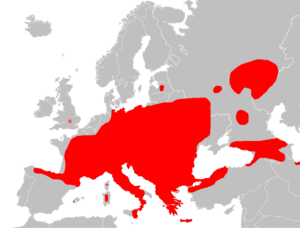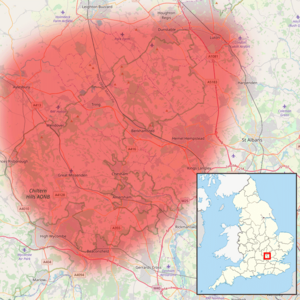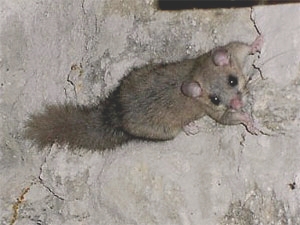European edible dormouse facts for kids
Quick facts for kids Edible dormouse |
|
|---|---|
 |
|
| Conservation status | |
| Scientific classification | |
| Genus: |
Glis
|
| Species: |
glis
|
 |
|
| European edible dormouse range (including portion of range of G. persicus in lower right) | |
| Synonyms | |
|
|
The European edible dormouse (Glis glis) is a type of large dormouse. It's one of only two living species in its group, called Glis. You can find these dormice in most parts of Europe and some areas of western Asia. They got their name because the ancient Romans thought they were a tasty treat!
Contents
Discover the Edible Dormouse: Appearance and Features
The European edible dormouse is the biggest of all dormice. Its body is about 14 to 19 cm (5.5 to 7.5 in) long. Its tail adds another 11 to 13 cm. Usually, it weighs between 120 to 150 g (4.2 to 5.3 oz). However, before hibernation, it can almost double its weight!
This dormouse looks a bit like a squirrel. It has small ears, short legs, and large feet. Its fur is grey or greyish-brown over most of its body. Its belly and the inside of its legs are white or light cream. The color change between these areas is quite clear.
Unlike many other dormice, it doesn't have dark marks on its face. It only has faint rings around its eyes. The tail is long and bushy. Its fur is a little darker than the fur on its body. Its front feet have four toes, and its back feet have five. The bottoms of its feet are bare. Female dormice usually have four to six pairs of teats.
The edible dormouse can drop its tail if an animal grabs it. The skin breaks easily and slides off the bone. This helps the dormouse escape. The exposed bones then break off, and the wound heals. New fur grows back on the tail.
Where Edible Dormice Live: Distribution and Habitat
You can find the edible dormouse across much of mainland western Europe. They also live on several Mediterranean islands, like Sardinia, Corsica, Sicily, and Crete. They are less common in central Europe and the Balkans. But you can find them as far north-east as the upper Volga River in Russia. Small groups are found near the Volga River in the Zhiguli Mountains. They also live in the Caucasus region. Germany has a small number of edible dormice, with about two to six individuals per hectare.
They are also found in scattered groups in Thrace, which is at the southeastern tip of the European Balkan peninsula. In this area, two types of edible dormouse are found: G. g. glis and G. g. orientalis. Northern Anatolia has a different type, G. g pindicus.
A small group of Glis glis also lives in south-east England. Around 1900, a British banker and zoologist named Lionel Walter Rothschild kept Glis glis in his collection in Tring, Hertfordshire. In 1902, some of these animals escaped. They reproduced and started living in the wild as an invasive species. Today, there are thought to be about 10,000 edible dormice in Britain. They have been seen within a 25-kilometre (16-mile) area around Tring. Most of them are found to the south and east. This area is like a 200-square-mile (520 km2) triangle between Beaconsfield, Aylesbury, and Luton, near the southeast side of the Chiltern Hills.
A different group of dormice lives along the coast of the Caspian Sea. They stretch from southern Azerbaijan west through Iran to Turkmenistan. These were once thought to be G. glis. However, scientists now know they are a separate species called the Iranian edible dormouse (Glis persicus).
Edible Dormouse Ecology and Habitat
Edible dormice live in forests with oak and beech trees. They can be found from sea level up to 1,500 to 2,000 m (4,900 to 6,600 ft) high. They like thick forests with rocky cliffs and caves. But they can also live in shrubland, orchards, and near cities. They have often been found in caves as deep as 400 m (1,300 ft). These caves offer them shelter from animals that might hunt them.
The number of dormice in an area can range from two to 22 per hectare. Female dormice stay in very small areas, about 0.15 to 0.76 ha (0.37 to 1.88 acres). Males, however, use much larger areas, from 0.8 to 7 ha (2.0 to 17.3 acres), and may have several burrows.
Edible dormice mainly eat plants. They feed on berries, apples, and nuts. But they can adapt to different foods. They have also been seen eating bark, leaves, flowers, insects, and even eggs. Beech tree seeds are a great food source for young and nursing females. These seeds are full of energy and protein. Sometimes, hair and tiny insect parts are found in their stomachs. This usually happens by accident when they groom themselves.
Edible dormice eat many beech tree seeds. One large, seeding tree in a dormouse's area can provide enough food for them to have babies. The location and age of a beech tree help decide where a group of dormice will live. This is because older trees produce more seeds.
Edible Dormouse Behavior
Edible dormice are active at night. During the day, they rest in nests they take from birds, or in hollow trees or other safe spots. They are good climbers and spend most of their time in trees. However, they are not very good at jumping. They use sticky stuff from glands on their feet to help them climb on smooth surfaces without falling. They usually stay in the forest and avoid open areas. They are not very social animals, but sometimes small groups of related adults have been seen together. Many female dormice create shared nesting areas where they raise their young together.
They communicate using sounds, like squeaks or snuffling noises. They also use scent. They leave scent trails from glands on their feet and at the top of their tails.
Edible dormice are active for about six months. They go into hibernation from around October to May. The exact timing depends on the weather. They are most active in the summer. They are active for about 202 minutes in a 24-hour day, mostly at night. They make a den in soft soil or a hidden cave. They rely on the fat they stored to survive the winter. During hibernation, their body temperature and how fast their body works drop a lot. They might even stop breathing for up to an hour. In years when there is not much food, edible dormice can hibernate for more than 11 months.
In the wild, most edible dormice hibernate for three winters. They then die in the fourth winter while hibernating. This happens because their teeth become too worn down to chew food properly.
Their main predators include owls, snakes, foxes, pine martens, weasels, and wildcats.
Edible Dormouse Reproduction and Life Cycle
The breeding season for edible dormice is from late June to mid-August. However, both male and female dormice do not have babies every year. How much food is available greatly affects if they reproduce. This is because having babies needs a lot of energy from rich seeds. So, edible dormice breed when there is plenty of food. Females can have more young if they find foods rich in amino acids. These include flowers, unripe seeds, and insects. An abundance of energy-rich seeds helps newborn dormice gain enough fat for their first hibernation. Edible dormice have learned to adapt their lives to have the most babies possible. This depends on how often trees in their area produce energy-rich seeds. Females can have babies when they are about 351–380 days old. Males lose a lot of body weight during mating season.
Male dormice do not protect a specific area. They may visit the areas of several nearby females to mate. They become aggressive towards any other males they meet. The male attracts a female by squeaking. Then, he does a circular dance before mating. During mating season, males lose body weight. They use their stored body fat to provide the energy needed for reproduction.
Pregnancy lasts from 20 to 31 days. A female can give birth to up to 11 young, but four or five is more common. Their fur grows by 16 days old. They open their eyes after about 3 weeks. They start leaving the nest after about 30 days. They are old enough to have their own babies after their second hibernation. Compared to other mammals of similar size, they live for a very long time. Some have been known to live up to 12 years in the wild.
Edible Dormouse and Humans
As a Pest

Glis glis have learned to live well near humans. They often hibernate in insulated attics. They even hide in dark cupboards, especially if there are soft materials to make a nest. When they do this, people usually see them as a pest. There have been cases where house fires were blamed on electrical wires chewed by Glis glis.
Even though they are seen as a pest in the United Kingdom, the Wildlife and Countryside Act 1981 makes it illegal to kill dormice in certain ways. This is because the Gliridae family of rodents is protected around the world. This protection comes from the Berne Convention on the Conservation of European Wildlife and Natural Habitats, which the United Kingdom has signed. To remove edible dormice from a property, only a trained pest controller licensed by Natural England can do it. They must use special traps. The animals must then be humanely put down after they are caught.
If there are many edible dormice, they can damage fruit trees in orchards. This also makes them pests.
As Food
The edible dormouse was raised and eaten by the ancient Romans. The Gauls and the Etruscans also ate them, usually as a snack. This is why the word "edible" is in its name. The Romans would catch dormice from the wild in autumn when they were fattest. They kept and raised these dormice in large pits or in special clay pots called gliraria. These pots were similar to hamster cages today. They fed the captive dormice walnuts, chestnuts, and acorns to make them fatter. The dormice were served roasted and dipped in honey. Or they were stuffed with a mix of pork, pine nuts, and other flavors. For upper-class Romans, it was important to serve dormice separately from other hunted animals.
Wild edible dormice are still eaten in Slovenia and Croatia. In Slovenia, they are a rare treat. Trapping dormice is a tradition there. Slovenians use several ways to trap them. The first methods used were trapping them in hollow trees and under flat stones. By the 17th century, trappers had invented the first traps that set themselves off. These were usually made of different kinds of wood. In the 19th century, traps made from iron and steel were introduced. Trappers used many different baits to attract the dormice. These ranged from pieces of fruit to bacon soaked in brandy. During the best season, trappers could catch between 200 and 400 dormice. This depended a lot on the type of trap they used. Seasonal dormouse feasts gave poor farmers much-needed protein. People in Slovenia did not just catch dormice for their meat. Using dormice for food and fur, and dormouse fat as an ointment, has been recorded there since the 13th century.
Images for kids
See also
 In Spanish: Lirón gris para niños
In Spanish: Lirón gris para niños






